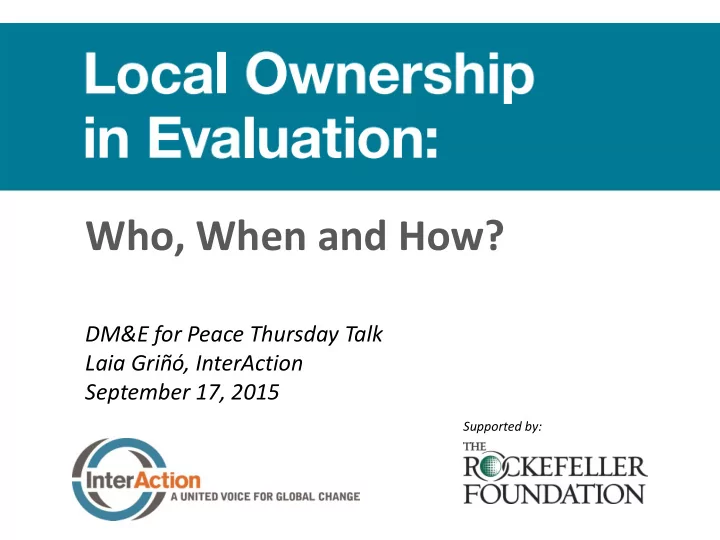

Who, When and How? DM&E for Peace Thursday Talk Laia Griñó, InterAction September 17, 2015 Supported by:
What is Local Ownership in Evaluation? Program participants are involved in evaluation decision making • Evaluations won’t only reflect our or funders’ values and interests, but those of program participants as well • Evaluations won’t just meet our needs, but also those of the people and communities we serve • Participants have a say in what is considered success or failure
Targeting the Ultra Poor Field Experiment Measures of Effectiveness • Improve targeting of a CCT • Accuracy of targeting program in Indonesia • Satisfaction • Three targeting • Costs methodologies 1. Proxy means testing (status quo) 2. Community based targeting 3. Self-targeting Source: Targeting the Ultra Poor: Evidence from a Field Experiment in Indonesia
Results Accuracy of Targeting Satisfaction 1. Self targeting 1. Community targeting 2. Proxy means testing 2. Proxy means testing 3. Community targeting 3. Self targeting Least Cost (overall) Least Cost (to households) 1. Community targeting 1. Proxy means testing 2. Self targeting 2. Community targeting 3. Proxy means testing 3. Self targeting
Feasible? Ethical? Appropriate? • Will participants’ input influence decision making? • Will participants gain something from being involved? • Do participants want to be involved? • Can participants be involved? • Does the evaluation team have skills to facilitate participation in the evaluation decision-making process? • Will participants be put at risk? • Will involving participants in evaluation decision making raise expectations that cannot be met?
Three Dimensions of Local Ownership in Evaluation Who When How Evaluation 8. Equal partners design 7. Lead action 6. Involved in Data decision making collection & 5. Consulted analysis 4. Informed Findings & 3. Tokenized recs. 2. Decoration Dissemination 1. Manipulated & use of results
Who: Selecting Participants • Transparent, fair process • Cognizant of power dynamics • Inclusive of all groups • Seeking legitimate representatives • Aware of biases • Differentiating roles: decision makers vs. informants
When: Expanding Participants’ Involvement Developing theory Developing of change Assisting with data evaluation collection recommendations Identifying/ prioritizing eval. Providing data Hearing questions evaluation results Shaping Identifying evaluation Assisting with outcomes/impacts findings dissemination Selecting Providing feedback Participating in indicators on evaluation decision making findings around Deciding on eval. evaluation results methods
How: Roger Hart’s Ladder of Participation Participant Evaluation design Data collection and Findings and Disseminating and using Involvement analysis recommendations results Together, participants and Participants are involved Rung 8: Participants help develop Participants are involved Participants share evaluators: appropriate measures in framing evaluation in disseminating - Develop theory of change findings and developing decision making with (see this example from evaluation findings. others as equal - Identify outcomes CARE / Everyday Peace evaluation Participants are - Determine eval questions recommendations. partners Indicators) responsible for acting on - Select relevant indicators some of the evaluation - Identify criteria for success Participants are involved recommendations. - Design data collection in data analysis. approaches - Decide data sources and samples Rung 5: Participants provide input Participants provide Participants provide Participants provide Participants into the evaluation design. data and may also be feedback on/validate the input on how evaluation consulted and involved in data evaluation findings and results are disseminated informed collection; recommendations. and used. Participants assist with data analysis. Data is shared with participants for their input. Rung 4: Information about the The data collected and Participants are presented with the finalized Participants purpose and nature of the evaluator-conducted evaluation findings and recommendations. informed evaluation is provided to analysis are shared with participants. participants.
A Few Examples • Community/partner participation in baselines • “Transparency Boards” • Funding for post- evaluation community engagement/feedback sessions • Conduct an assessment of current practice • Set a “minimum standard” (see DFID report: Beneficiary Source: Data by the People, for the People: Feedback in Evaluation) Participatory Monitoring & Evaluation at The Hunger Project
Final Thoughts • Local ownership in evaluation should not be considered “advanced” practice or a worthwhile “extra” • Don’t feel you have to do everything at once • Local ownership does not mean that participants have to do everything themselves • Use of participatory methods alone does not guarantee ownership • Can you do use a local ownership approach if a project hasn’t been participatory? • Isn’t evaluation too late to be participatory? Shouldn’t we be talking more about monitoring?
Recommend
More recommend